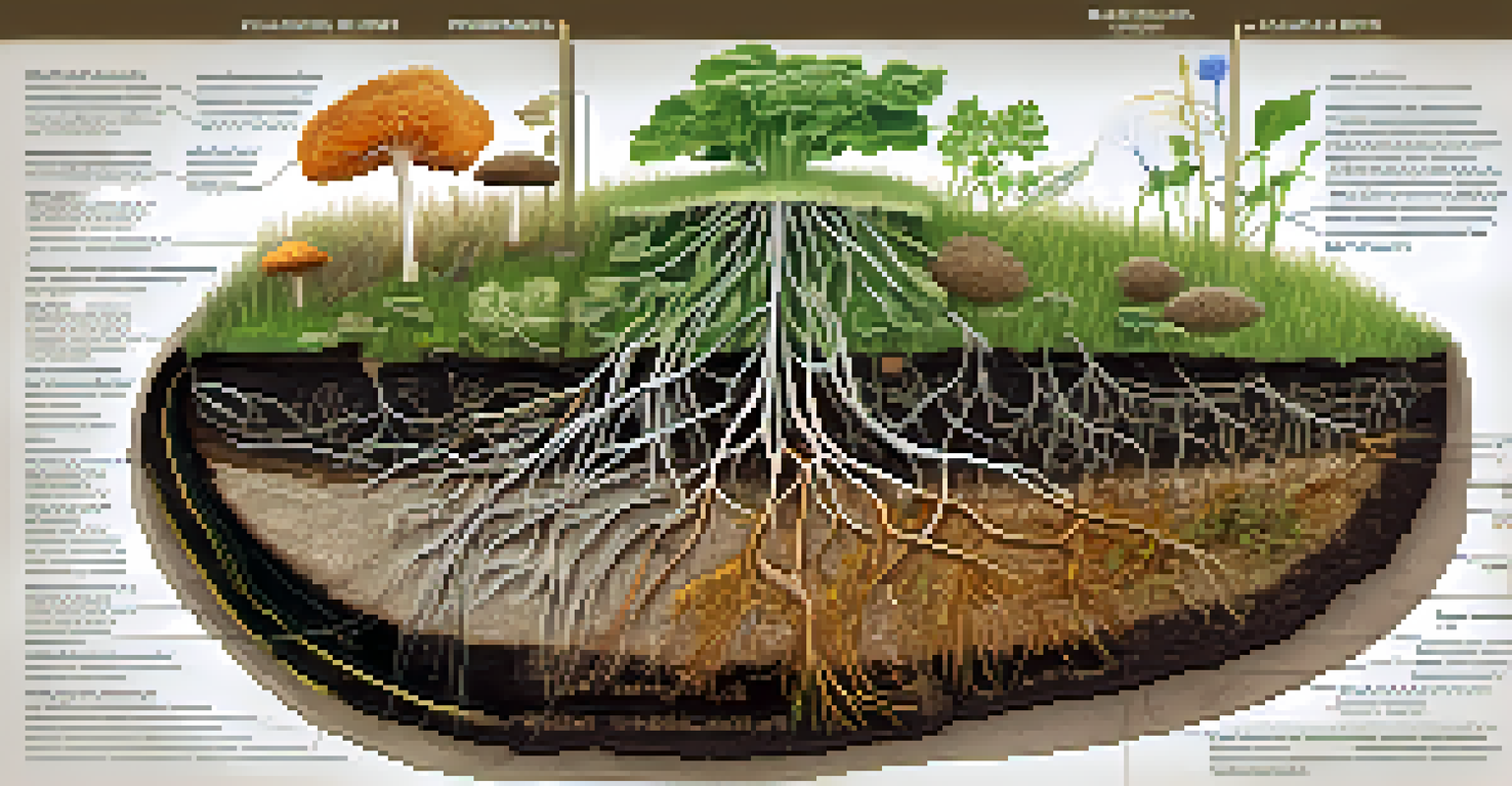Impact of Mycorrhizal Fungi on Drought Resistance in Plants

Understanding Mycorrhizal Fungi and Their Role
Mycorrhizal fungi form a symbiotic relationship with plant roots, helping them absorb essential nutrients from the soil. This partnership is a win-win; plants provide carbohydrates to the fungi, while the fungi enhance the plant's access to water and nutrients. This relationship is especially vital in ecosystems where soil conditions can be challenging.
The soil is the great connector of our lives, the source and destination of all. It is the healer and the teacher, the giver and the taker of life.
The fungi extend the root system of plants, increasing the surface area for absorption. This is akin to having a personal assistant who can reach resources that you cannot. By tapping into moisture and nutrients from a larger volume of soil, these fungi play a crucial role in plant health, especially during dry spells.
In essence, mycorrhizal fungi act as an invisible safety net for plants, allowing them to thrive in less-than-ideal conditions. This is particularly important in regions prone to drought, where every drop of water counts.
Drought Stress and Its Impact on Plants
Drought stress occurs when plants do not receive enough water, leading to a range of physiological issues. Without adequate moisture, plants may exhibit wilting, stunted growth, and reduced yield. This can be detrimental not just for the plants themselves but also for the ecosystems and agricultural systems that rely on them.

During drought, plants often close their stomata, the tiny openings on leaves, to conserve water. While this is a protective mechanism, it also limits gas exchange and can hinder photosynthesis, the process by which plants produce energy. In severe cases, prolonged drought can lead to plant death, dramatically altering habitats.
Mycorrhizal Fungi Aid Nutrient Uptake
These fungi enhance plants' ability to absorb essential nutrients and water, especially in challenging soil conditions.
Understanding the effects of drought stress is crucial for developing strategies to enhance plant resilience. As climate change continues to exacerbate water scarcity, finding ways for plants to cope with these challenges is more important than ever.
How Mycorrhizal Fungi Enhance Drought Resistance
Mycorrhizal fungi improve drought resistance by improving water uptake in plants. They achieve this by exploring deeper soil layers that roots alone may not reach, effectively acting as a network of water-seeking agents. This capability allows plants to access moisture even during dry conditions, enhancing their survival chances.
In nature, nothing exists alone.
Additionally, these fungi help plants maintain turgor pressure, which is essential for keeping cells rigid and healthy. You can think of turgor pressure as the air in a balloon; without it, the structure collapses. By ensuring that plants retain adequate water, mycorrhizal fungi help them maintain their strength and vigor during drought.
Moreover, plants with mycorrhizal associations often show improved resilience to not just drought, but also other stressors like soil salinity. This resilience can be vital for agricultural practices in arid regions where water resources are limited.
The Science Behind Mycorrhizal Associations
Research shows that mycorrhizal fungi can increase a plant's drought tolerance by modulating physiological processes. For instance, plants with these fungal partners tend to have better root growth and deeper root systems, which are critical for accessing moisture. This scientific understanding helps us appreciate how these tiny organisms can have such a significant impact.
Studies have demonstrated that mycorrhizal plants can maintain higher leaf water potential during drought conditions. Leaf water potential is a measure of how much water is available to plants, and higher levels mean plants can continue to function optimally even when water is scarce.
Drought Resistance Through Fungal Aid
Mycorrhizal fungi improve plants' drought resistance by accessing deeper soil moisture and maintaining cellular strength.
This scientific backing reinforces the idea that fostering healthy mycorrhizal communities in soil can be a vital strategy for improving drought resistance in crops. As we continue to explore these relationships, the potential for enhanced agricultural practices becomes increasingly evident.
Real-World Applications in Agriculture
Farmers and agricultural scientists are increasingly recognizing the benefits of mycorrhizal fungi in sustainable farming practices. By incorporating mycorrhizal inoculants into the soil, they can improve plant resilience to drought and reduce dependency on chemical fertilizers. This approach aligns with organic farming principles, promoting ecosystem health.
In crops like corn and wheat, studies have shown that plants treated with mycorrhizal fungi exhibit better growth and yield even under drought conditions. For farmers, this means not just healthier plants but also potentially higher profits, making the case for integrating these fungi into their farming practices.
Moreover, adopting mycorrhizal fungi can lead to healthier soils overall. The enhanced soil structure and nutrient availability promote biodiversity, which is crucial for resilient farming systems that can withstand climate fluctuations.
Challenges in Utilizing Mycorrhizal Fungi
Despite their benefits, there are challenges in harnessing the power of mycorrhizal fungi effectively. One significant hurdle is the variability in fungal species and their effectiveness in different soil types and conditions. Not all fungi are equally beneficial, and understanding which species work best in specific environments is key to successful implementation.
Another challenge is the disruption of mycorrhizal networks through conventional agricultural practices, such as soil tillage and the use of chemical fertilizers. These practices can negatively impact the delicate balance of soil ecosystems, making it harder for mycorrhizal fungi to thrive and provide their benefits to plants.
Sustainable Farming with Fungi
Incorporating mycorrhizal fungi in agriculture promotes healthier plants, reduces chemical fertilizer use, and enhances soil biodiversity.
Awareness and education about the importance of mycorrhizal fungi are essential for overcoming these challenges. By promoting practices that support these relationships, we can maximize their potential in improving drought resistance and overall plant health.
Future Directions in Mycorrhizal Research
The future of mycorrhizal research holds exciting possibilities, especially as we face the challenges of climate change. Ongoing studies are exploring how these fungi can be engineered or selected for specific environments, enhancing their effectiveness in promoting drought resistance. This targeted approach could revolutionize agricultural practices, making crops more resilient.
Researchers are also investigating the genetic mechanisms behind plant-fungal interactions. By understanding the molecular basis of these relationships, scientists hope to identify traits that enhance drought tolerance, which can be bred into crop varieties. This research could lead to the development of super-resilient plants that thrive even in adverse conditions.

Ultimately, the integration of mycorrhizal fungi into modern agriculture could play a crucial role in sustainable food production. As we continue to discover more about these fascinating organisms, we can better equip ourselves to face the challenges posed by a changing climate.